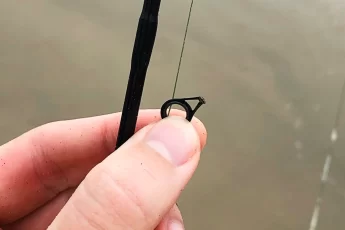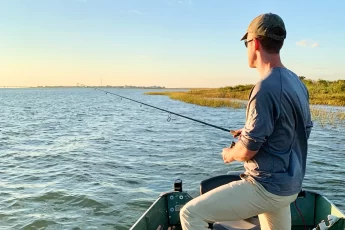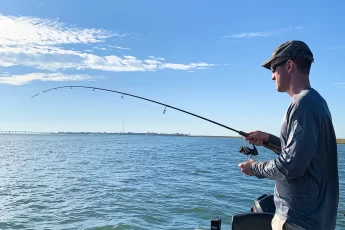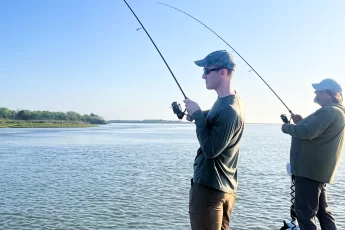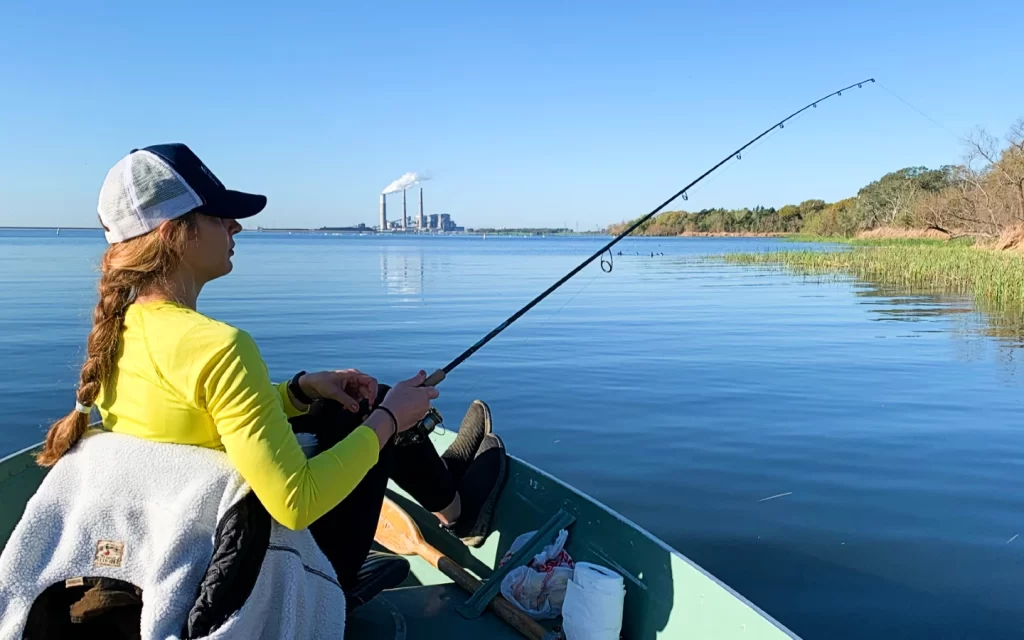
Updated 2/13/2024
Light finesse setups and dock skipping are popular bass fishing techniques that are best suited for spinning rod and reel setups. Spinning setups can handle lighter line and don’t have the tendency to backlash like baitcasting reels do. Having the best bass spinning rods is critical for comfortable, accurate casting for these lighter weight bass fishing techniques.
We’ve done the hours of testing and research on the best bass spinning rods assessing versatility, value for the price, material quality, and much more so you don’t have to. Read on to see our top picks.
*Disclosure: I only recommend products I would use myself and all opinions expressed here are my own. This post may contain affiliate links that at no additional cost to you, I may earn a small commission.
Our Top Picks
- Best for the Money: St. Croix Mojo Bass Spinning
- Best Under $100: Ugly Stik Elite Spinning
- Best Under $200: St. Croix Premier Spinning
- Best for Beginners: Shimano Solara Spinning
- Best Rod & Reel Combo: Penn Battle III Spinning Rod & Reel Combo
- Best for Flipping & Pitching: Penn Battalion II Inshore Spinning Rod
- Best High End: St. Croix Legend Elite Spinning Rod
The Best Bass Spinning Rods
While certain types of fishing poles may work for multiple popular bass fishing techniques, prudent bass anglers diversify their equipment to specialized fit-for-purpose poles. Bass spinning rod setups are a key part of the bass angler’s arsenal.
Read on to see our recommendations for the best bass spinning rods by category including best all-around, best for specific fishing techniques, best for beginners, and more.
1. St. Croix Mojo Bass Spinning
- Length: 6’8″ to 9’6″
- Rod Material: SCIII Carbon
- Guides: Kigan Master Hand 3D guides with Aluminum Oxide Rings
- Grip: Split premium cork grip
- Warranty: 5 Year
Pros:
- Premium rod at manageable price
- Excellent Warranty
Our choice for best for the money spinning bass fishing rod is the St. Croix Mojo Bass Spinning Rod. This rod is a perfect mix of quality components at a bargain price point for its premium features. The 6’8″, medium power, extra fast action version is perfect for a spinning finesse bass fishing setup. Don’t think twice about this rod for ned rigs, shaky head rigs, wacky rigs, or anything else that uses a light setup.
The rod blank is St. Croix’s proprietary SC III graphite fiber which is lightweight, durable, and sensitive with a higher strain rate than fibers commonly used by other rod manufacturers. The Mojo Bass rod line is on the lighter end of available bass rods with superior sensitivity without sacrificing strength.
This rod comes with the favorable St. Croix 5-year warranty. The Mojo Bass rods are premium rods at a manageable price point and a solid pick for a great deal for the money.
2. Ugly Stik Elite Spinning
- Length: 4’6″ to 7’6″
- Rod Material: Composite
- Guides: One-Piece Stainless Steel
- Grip: Cork Grip
- Warranty: 7 Year Manufacturing Warranty
Pros:
- Heavy Duty
- Budget entry point to bass fishing
For bass spinning setups under $100 we recommend the Ugly Stik Elite Spinning rod. Ugly Stik rods are known for being heavy duty, robust, and mostly budget friendly which is great for a first foray into bass fishing. Get a 6’6″ or 7′ medium power option as a starter, all-around rod.
This rod is a great choice for beginners or budget conscious anglers wanting to add a sturdy rod to their arsenal.
This rod is heavier than most on the list due to the composite construction. We like the cork grip for comfort and how robust the construction is for this rod. This rod is great for beginners to make mistakes with before purchasing a higher end rod.
For other great options check out our article on the best bass rods under $100.
3. St. Croix Premier Fishing Rod
- Length: 4’6″ to 8’6″
- Rod Material: SCII Carbon
- Guides: Kigan 3D guides with Aluminum oxide rings
- Grip: Full Premium Cork Grip
- Warranty: 5 Year
Pros:
- Tons of options in both spinning and casting variant
Our choice for the best bass spinning rod under $200 is St. Croix’s Premier Spinning Rod. This rod is perfect for lighter soft plastic setups and makes for a great all-around rod for walleye or panfish as well. This is one of St. Croix’s most popular rod lines for good reason. It comes in a wide range of lengths, powers, and actions so the prudent angler can pick the perfect rod for their needs.
We love the feel of the full cork grip handle. Both the casting and spinning variants of this rod are incredibly sensitive and a delight to fish with. As always, St. Croix’s warranty is a huge perk. We adore this rod line.
Check out our deep dive review on the St. Croix Premier rod line for more information. We also really like this rod line in the casting version.
4. Shimano Solara
- Length: 5’6″ to 7′
- Rod Material: Aeroglass Fiberglass
- Guides: Aluminum Oxide
- Grip: Cork
- Warranty: 1 year manufacturing defects
Pros:
- No-regrets price point makes for easy entry into fishing
Our choice for the best bass spinning rod for beginners is the Shimano Solara spinning rod. This rod is a no-regrets price point for true beginners to try out fishing. The build quality is acceptable but about what you’d expect at this price.
We recommend the 7′ medium power fast action version of this rod for a beginner looking for a starter spinning bass rod.
This rod is fiberglass which is heavier and less sensitive than the carbon graphite blanks of the other rods on this list. This is a two piece rod which can be solid perk for convenient storage.
While this rod is a super budget option, we generally recommend rod choices between $100 and $200 because we think rods in that price range are the most bang for your buck and will last much longer.
Check out our article on the best beginner fishing rods for other great options.
5. Penn Battle III Spinning Rod & Reel Combo
- Rod Length: 6’6″ to 10′
- Power: Light to Heavy
- Reel Size: 1000 to 8000
- Ball Bearings: 5+1
Pros:
- Wide range of available rod and reel sizes and powers for various applications
- Great value for the price
Our top choice overall for best bass spinning combo is the Penn Battle III Spinning Rod and Reel Combo which we feel is that perfect mix of premium quality with a manageable price tag. Heck, the Penn Battle III reel is one of our favorite reels so it’s no surprise if you slap it on a decent rod we’ll think highly of it!
We recommend the 3000 size reel with the 7′ medium-light rod for an awesome spinning bass setup.
The reel was the 2020 ICAST Online Best of Category Winner – Saltwater Reel, includes a 5+1 sealed stainless steel ball bearing system, Penn’s HT-100 carbon fiber drag washers, and a full metal aluminum body and side plate. It is high quality designed for durability and performance and Penn really outdid themselves with the attention to detail.
The rod blank is a graphite composite with either cork or eva handle depending on the model. It has plenty of backbone to reel in big surf species.
While we generally expect a rod & reel combo to skimp in quality on one of the components, we were pleasantly surprised with this pairing by Penn. This combo is great value for the price.
Check out our article on best bass fishing rod and reel combos for other great options.
6. Penn Battalion II Inshore Spinning Rod
- Length: 7′ to 8′
- Rod Material: SLC2 Carbon
- Guides: Fuji Alconite
- Handle: Premium Cork or Rubber Shrink Tube
- Warranty: 1 Year manufacturing defects only
Pros:
- Highly versatile for multiple fishing applications
- Heavier duty rod options fit for flipping & pitching
Our top choice for best bass flipping and pitching spinning rod is the Penn Battalion II Inshore Rod. This rod captures a great balance of value, price accessibility, and quality features.
It may seem like a strange choice to pick an inshore fishing rod for a bass technique. The challenge with flipping and pitching is that it requires long, sturdy, heavy power rods, and most freshwater spinning rigs don’t go above medium power.
We picked an inshore rod as our top spinning flipping and pitching rod because inshore rods are designed for bigger fish. This translates perfectly to the power needed for ripping big bass out of heavy cover.
We recommend the 7’6″ medium-heavy power or the 7′ heavy power version for this application.
The SLC2 Carbon rod blank and Fuji Alconite guide material construction are considered mid-tier materials that should last plenty long with proper care. The full cork handle feels great for prolonged fishing trips. We do wish Penn offered a better warranty (like St. Croix), but it’s hard to complain at this price point.
While we generally recommend a baitcasting setup for flipping and pitching, if you must have a spinning flipping and pitching rod, this is a great option.
Check out our article on flipping and pitching rods for other options.
7. St. Croix Legend Elite Spinning Rod
- Length: 6′ to 7’6″
- Rod Material: SCVI Carbon
- Guides: Fuji Torzite with titanium frames
- Grip: Super-grade cork
- Warranty: 15 Year Transferrable
Pros:
- Best money can buy
- Excellent Warranty
Our choice for the best high end bass spinning rod is the St. Croix Legend Elite Spinning Rod. We particularly like the 7′, medium-light power, fast action variant for finesse fishing.
St. Croix has crafted one of the lightest, strongest, most sensitive spinning rods available on the market.
The rod features four of St. Croix’s innovative technologies.
Integrated Poly Curve (IPC) eliminates all transitional points in the rod blanks for smoother actions, increased strength, and greater sensitivity.
Advanced Reinforcing Technology (ART) is an exotic carbon fiber material that adds a magnitude (10x) of strength with virtually no increase in rod blank diameter or weight and significantly improves the hoop strength of the blank by preventing it from deforming under severe loads (like the donkey bass you pull out of the slop)!
The Taper Enhancement (TET) blank design provides curved patterns for improved action and sensitivity.
And last but not least, rods manufactured with the Fortified Resin System (FRS) advanced manufacturing protocol consistently test 33% stronger than those built with standard resins and curing methods.
Also, St. Croix manufactures their high-end rod lines in Wisconsin for United States based anglers looking to support local manufacturing.
Rod Comparison Table
Check out our handy comparison table showing key specifications for our top rod choices.
| Rod Name | Length | Rod Material | Guides | Grip | Warranty |
|---|---|---|---|---|---|
| St. Croix Mojo Bass Spinning | 6’8″ to 9’6″ | SCIII Carbon | Kigan Master Hand 3D guides with Aluminum Oxide Rings | Split premium cork grip | 5 Year |
| Ugly Stik Elite Spinning | 4’6″ to 7’6″ | Composite | One-Piece Stainless Steel | Cork Grip | 7 Year Manufacturing Warranty |
| St. Croix Premier Fishing Rod | 4’6″ to 8’6″ | SCII Carbon | Kigan 3D guides with Aluminum oxide rings | Full Premium Cork Grip | 5 Year |
| Shimano Solara | 5’6″ to 7′ | Aeroglass Fiberglass | Aluminum Oxide | Cork | 1 year manufacturing defects |
| Penn Battle III Spinning Rod & Reel Combo | 6’6″ to 10′ | Composite | Penn Duraguides | Cork or Foam | – |
| Penn Battalion II Inshore Spinning Rod | 7′ to 8′ | SLC2 Carbon | Fuji Alconite | Premium Cork or Rubber Shrink Tube | 1 Year manufacturing defects only |
| St. Croix Legend Elite Spinning Rod | 6′ to 7’6″ | SCVI Carbon | Fuji Torzite with titanium frames | Super-grade cork | 15 Year Transferrable |
Conclusion
Bass fishing covers a huge range of techniques making it tough to recommend one bass rod for everything. Lighter bait setups are better fished with spinning rods and reels due to their inability to backlash and capability to use lighter line.
The St. Croix Mojo Bass is our choice for the best for the money bass spinning rod due to it’s premium features at a manageable price point.
Check out our articles for great reels to pair with these rods:
Check out our related rod articles:
- Best Bass Fishing Rods
- Best Baitcasting Rods for Bass
- Best Smallmouth Bass Rods
- Best Flipping & Pitching Rods
- Best Jig Rods for Bass
- Best Frog Fishing Rods
Check out our related rod and reel combo articles:
Read on to see our breakdown of important factors to consider when picking a bass spinning rod.
How to Choose The Best Bass Spinning Rod
Selecting the best bass spinning rod focuses on picking rods for finesse bass fishing techniques. This requires choices based on rod powers, lengths, actions, and materials.
For even more reading, check out our article on how to choose any fishing rod.
Length
Rod length is an important consideration for bass anglers. Longer rods allow for longer casts with less effort while shorter rods allow for improved casting accuracy. Most bass rods are between 6’6″ and 7’6″. Seven foot rods are a great all-purpose length.
Techniques like flipping, pitching, and punching are better suited for rods from 7’6″ to 8′ long to allow for a sweeping, accurate swing of the bait to the target.
Swimbaits, crankbaits, spinnerbaits, finesse worms, and other soft plastics presentations have slightly more flexibility in rod length options. If the bass are hanging tight to cover, a rod closer to 6’6″ allows for unparalleled casting accuracy. If covering water searching for fish, a rod around 7′ is an excellent balance of casting accuracy and casting distance.
Power
Rod power is the fishing industry’s terminology for rod stiffness. Rod powers range from ultralight to heavy.
Medium rod power is a great all-around option that can be used with most bass fishing techniques.
Heavy power rods are a better option for frog fishing, flipping, and pitching because bass caught with these techniques are commonly in thick cover and additional rod backbone is needed to pull them out.
Finesse techniques like Texas rig fishing soft plastic worms or drop shotting is better with medium-light to medium power equipment due to the increased sensitivity these rods offer.
Action
Rod action refers to how far down the rod will bend when pressure is applied to the tip. Rod actions range from extra-fast (bends near tip) to slow (nearly the whole rod bends).
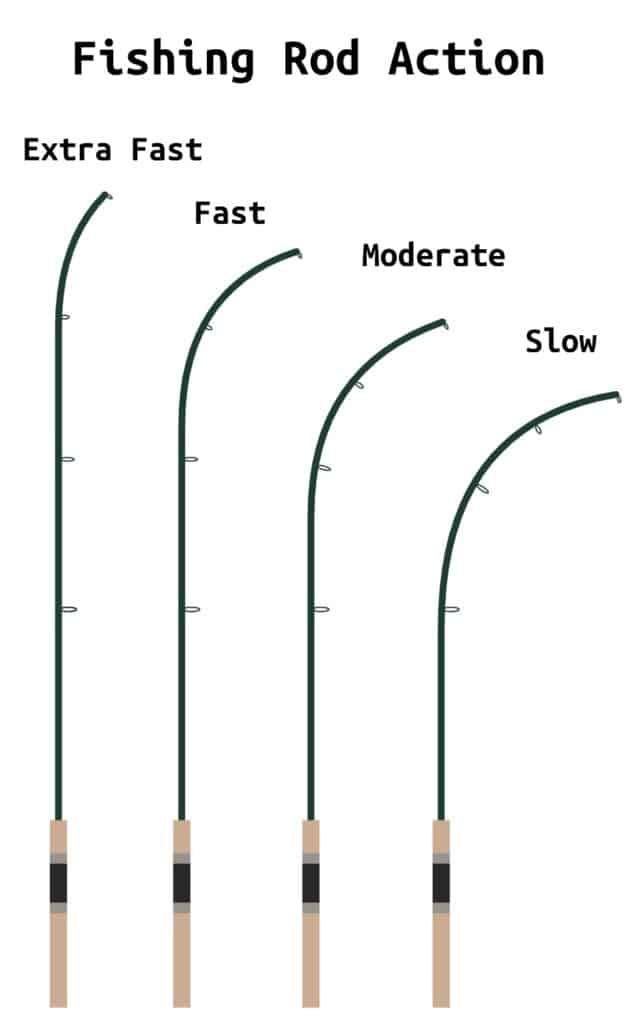
The faster the action, the more sensitive the rod will feel. The slower the action, the more casting distance you can get (the rod will feel like it whips more when you cast).
The best bass spinning rod action depends on the fishing technique. Single hook techniques that require a firm hookset, like finesse worms, spinnerbaits, buzzbaits, bass jigs, flipping, and pitching are best with fast or extra-fast actions to allow for a firm hookset.
Lures and baits with treble hooks, like crankbaits, are best with moderate actions because the sweeping hooksets with these flexier rods are more effective with the additional give in a moderate action rod.
Slow action rods are no longer common for bass fishing and are not the preferred action for any bass fishing techniques.
Check out our article on fishing rod actions for even more information.
Portability
Portability is an important factor for any fishing pole. Anglers purchasing a bass spinning rod should consider how they are going to transport the rod. Ensure the length rod will fit in your boat or vehicle. Seven foot rods will fit in most vehicles but anything above 7’6″ may not fit in boat rod storage or smaller vehicles. Additionally, think about getting a 2 piece rod if portability is a major concern.
Handle Material
Rod handle feel is an important factor to consider when picking a bass spinning rod. Common handle types are full cork, partial cork, rubber shrink tube, cork tape, or EVA foam. Rubber shrink is usually considered a more budget option, whereas full cork feels better to grip and handle. For techniques that require forceful hooksets like pitching and flipping, EVA foam may be a better option because it is not slippery when wet.
Rod Guide Material
Rod guide material is important because lower quality materials are heavier and will rust quicker and could potentially fail.
The highest end rods have titanium or silicone carbide (SiC) rod guides whereas middle end or budget rods will have some variation of aluminum oxide or stainless steel.
Higher end rod guides are made with lighter materials with lower friction that will either rust slower or not at all. Less expensive rod guides are heavier and will succumb to the elements more quickly.
For additional information on rod guide considerations, check out our article that explains fishing rod guides in detail.
Rod Material
Rod blank material affects rod strength and how the fishing rod deforms during casting or reeling in a fish. Common rod materials are graphite, fiberglass, and composite. Check out our deep dive on rod blanks for more information.
Graphite
Graphite rods have incredible sensitivity in lightweight packages. They are great for detecting subtle fish strikes. Graphite rod disadvantages are that the rods can be a little weaker than the other options and more susceptible to breakage, especially around nicks or scratches.
Fiberglass
Fiberglass is strong, durable and flexible but weighs more than graphite. They are less sensitive than the other types of rod materials.
Composite
Composite rod materials are a mix of graphite and fiberglass that seek to have the light weight and sensitivity of graphite rods with the strength of fiberglass rods.
Reel Seat
Reel seats are the component where the fishing reel is secured onto the fishing rod by tightening a locking nut. The basic parts of a reel seat are the body, hood, locking nut, and barrel threads. Common reel seat materials are either graphite or aluminum which are both lightweight, corrosion resistant materials. Reel seats are sized to match the power of the rod. For example, a reel seat on an ultralight fishing rod won’t fit a massive 10000 size spinning reel.
Most freshwater applications utilize fully graphite reel seats due to graphite’s light weight. For heavier duty saltwater applications, reel seats are commonly upgraded to machine-grade aluminum for increased strength. For targeting the largest fish on the planet, the complete rod butt and reel seat can be aluminum for maximum strength.
Maintenance and Care
Maintaining your fishing rod ensures its longevity and performance. After each use, rinse it with fresh water to remove dirt and debris, especially if you’ve been fishing in saltwater. Dry it thoroughly before storage to prevent rust and corrosion. Occasionally check for any signs of wear or damage. Store your rod vertically or horizontally on a rack, avoiding extreme temperatures or direct sunlight.
Explore our ultimate guide on fishing rod maintenance and care for comprehensive insights into maintaining your bass spinning rod, avoiding common causes of damage, and mastering preventative strategies to ensure your gear remains in prime condition.
Bass Spinning Rod Frequently Asked Questions
What reel to pair with bass spinning rod?
Bass fishing rods are best paired with high-quality reels that match the rod type. Spinning rods should be matched with spinning reels. Spinning reels between 2500 and 4000 sizes are perfect for bass fishing applications. Higher end reels will have smoother drag and better brake systems which can make them easier to fish for extended periods of time.
What is the best length bass spinning rod?
The most versatile, all around best length bass fishing rod is 7 feet long. This length rod is a perfect balance of accuracy, casting distance, and comfort for the angler. It is easy to transport in vehicles and boats, and can be effectively used for the most popular bass fishing techniques.
Are spinning rods good for bass?
Spinning rods are great for certain bass fishing applications. Finesse fishing with light setups is better with spinning setups due to their inability to backlash and capability of holding lighter lines. Also, spinning rods are easier for beginners to use and a great choice when starting out.
Is a 6ft pole good for bass fishing?
Most bass anglers prefer fishing rods around 7 feet long because that rod length is a versatile mix of accuracy, casting distance, and comfort. Six foot rods are easier to cast accurately, but may lack in casting distance compared to longer rods.
What pound test line for a bass fishing rod?
For finesse bass techniques like Texas rigged worms and drop shotting, use 6-10 pound test braided line. If fishing spinnerbaits, crankbaits, or swimbaits, bump up to 15-20 pound test line. For flipping, pitching, and frog fishing, 30-65 pound test braided line allows anglers to retrieve fish through the thickest cover.
Is mono or braid better for bass fishing?
Braided fishing line is preferable for bass fishing because it has significantly smaller diameter for the same strength line when compared to mono. Braided line can be cast further and also has less tendency line twist than mono. Mono stretches more than braid, which can be a positive for fishing techniques like crankbait fishing that require more give in the line.

Written By: Andrew Juran
Andrew is a seasoned angler with over 25 years of experience fishing across the United States. He has caught hundreds of bass using various techniques and mentored many in the art of fishing. An advocate for sustainable fishing, Andrew is an active member of the Coastal Conservation Association, an organization committed to marine conservation.
For frequent fishing tips, behind-the-scenes looks, and real-time catches, connect with Andrew on Instagram










